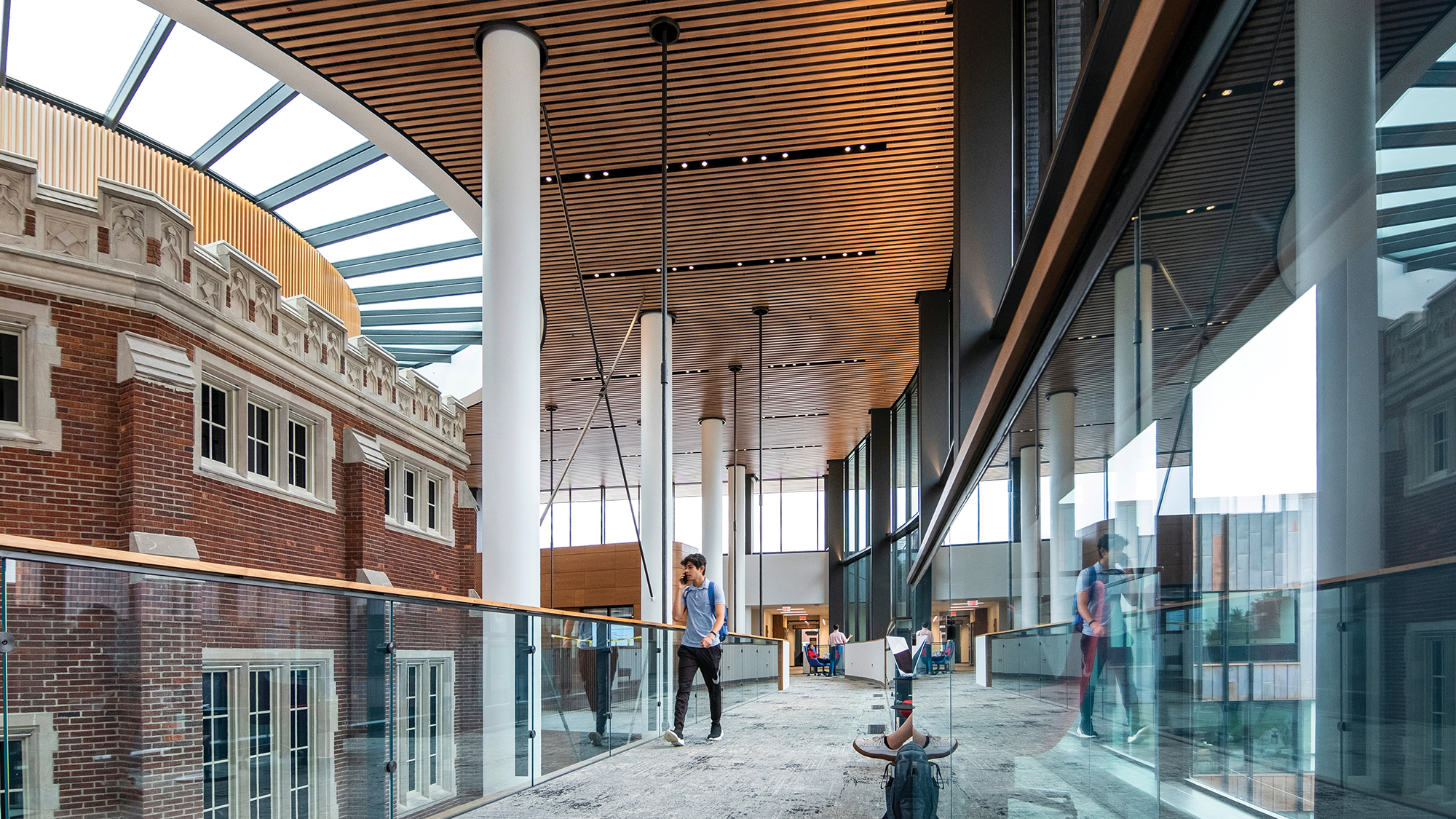Building the Humanities
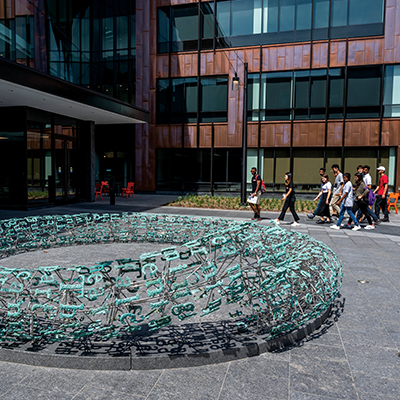
Broken English, a monumental sculpture created by Gregory Gómez ’80, graces the HSSC plaza. Read vertically, the sand-cast bronze letters around the circumference repeat the first few lines of W.B. Yeats’ poem, “The Second Coming.” The sculpture was a gift to the College from John B. Chambers ’77. Read more about the inspiration for the art and the friendship between the artist and donor.
With its formal dedication on Oct. 1, 2022, the Humanities and Social Studies Center (HSSC) at 1226 Park St. is now an official part of the Grinnell campus.
However, the three-story, 196,600-square-foot facility, designed with input from faculty, staff, and students, has been a part of the landscape since construction of the first phase was completed and the first classes were taught in its classrooms in spring 2019. The COVID-19 pandemic that forced campus to shut down in 2020 necessitated postponement of grand opening and dedication ceremonies for the building and delayed recognition and utilization of the HSSC’s full potential.
As students began the return to campus last year, and then in full force this past spring, the HSSC demonstrated its full capacity as a gathering place that facilitates teaching and learning, inspires collaboration and exploration, spurs creativity, and brings focus to the College’s commitment to the humanities and social studies and the importance of a liberal arts education.
“The HSSC is designed to inspire people,” says Caleb Elfenbein, professor of history and religious studies and director of the Center for the Humanities. “It is beautiful, inviting, and stands as a real statement of the values of this community. I’m entering my 13th year here, and being able to walk into the building’s magnificent public atrium and into those classrooms, which are amazing spaces in which to use a variety of pedagogical approaches to facilitate humanistic learning — it’s all just so inspiring.”
Why the Humanities?
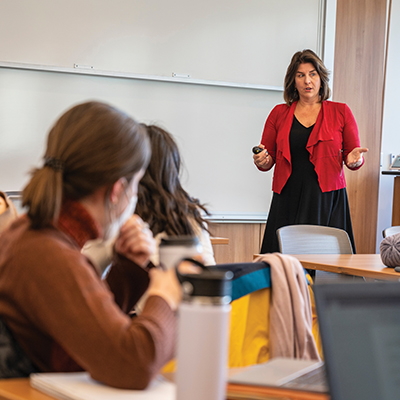
Professor of Sociology Karla Erickson teaches her popular Sociology of Robots artificial intelligence class in the HSSC, where students can study the logic of devices, robots, and algorithms, as well as their implications for the humans who use them, in a hands-on environment.
Studying the humanities helps us determine what is important in our lives and our communities. It helps us make connections with other people and cultures; to discover our similarities and celebrate our differences.
It’s a means to gaining knowledge and taking action to create a more just and equitable society. In short, it helps transform students into Grinnellians.
“Culturally and politically, the value of the humanities has been under question for some time,” says Elfenbein. “The creation of the HSSC, with its focus on the humanities and humanistic social studies, particularly in the current cultural climate, is a significant statement on Grinnell’s part. It demonstrates our commitment to the humanities and our recognition that they are a crucial part of a liberal arts education and an important part of preparing students for citizenship, meaningful professions, and fulfilling personal lives.”
The commitment to advancing humanities education garnered major validation and financial support just as the HSSC was coming online in early 2019, when the Andrew W. Mellon Foundation awarded Grinnell College a $1 million grant for a “Humanities in Action” project. The Mellon grant is focused on curricular reform, community engagement, career development, and other efforts to highlight the vitality and importance of the humanities, the humanistic social sciences, and the arts in the public sphere. Ultimately, the HSSC and funding such as the Mellon grant will enable students to take amazing new classes that could change the way they think about their education.
But the study of the humanities is important not only for its lofty ideals and introspective questioning. By some estimates, current college students will change careers five to seven times over the course of their professional lives. A well-rounded understanding of the humanities and possession of the so called “soft skills” learned through the study of philosophy, literature, history, and the other humanities is a great asset in a world that requires multitasking across disciplines and knowledge across multiple fields.
While she was studying political science at Grinnell, Gwenna Ihrie ’15 was part of the multidisciplinary planning committee for the HSSC. She recalls the process as one that considered equally the opinions of all members of the committee, whether a vice president or a student.
“I felt it was important for students in the humanities to have their own spaces to collaborate, to think about their work, and have resources and support systems that were easily accessible and specifically for them,” she says. “I think that focus was very important and said to humanities and social studies students: ‘You are not forgotten, and you are important on this campus.’ It's also important because we are a school that was founded on the principles of social activism, and many students enter careers and lead lives with a social justice component that is a direct result of studying the humanities.”
Designed for Teaching and Learning
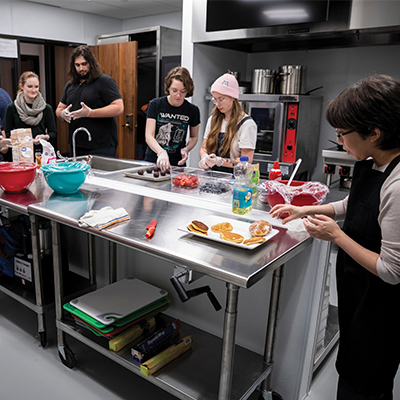
It’s not surprising that The Marcus Family Global Kitchen is a very popular hub of activity in the HSSC. There, students can get hands-on practice preparing foods of a region they are studying while also exploring the potential of food for global engagement and transformation.
With an award-winning design (see HSSC Recognized for Continuing Architectural Excellence at Grinnell) that incorporates natural light, serpentine walkways, and myriad spaces for casual or formal get-togethers, the HSSC is often described in purely aesthetic terms: Beautiful. Inspiring. Comfortable. Warm. Inviting.
Though completely accurate and appropriate, these words paint only a partial picture of the space, which Grinnellians also describe as: Useful. Practical. Smart. Adaptable.
These aspects of the building, as much as its aesthetic components, were intentionally and purposefully incorporated into its design from the early stages of planning, and aptly translated into reality by the architectural firms of EYP Inc. of Boston and OPN Architects of Des Moines, Iowa, and the building’s primary contractor, McGough Construction of Minneapolis.
“It’s beyond anything I could have imagined or dreamed of when we were first planning and thinking about the building,” says Ihrie. “I’ve walked through it, and it brought a tear to my eye as I thought about all the opportunities that would be available for students that we didn’t have access to. I just think it’s amazing — the flow, the architecture, and just the grandeur of the building. It’s kind of prairie humble in that it accomplishes a lot without feeling like it’s a lot.” But it is a lot.
The HSSC features four pavilions — two new and two renovated — joined by a central, three-story atrium with connecting bridges at floors two and three. The historic Alumni Recitation Hall (ARH) tower dominates the atrium, which adjoins a café, the Institute for Global Engagement (IGE), and the Data Analysis and Social Inquiry Lab (DASIL). There are 39 technology-rich classrooms and inquiry labs, offices for humanities and social studies faculty members, meeting rooms, study nooks, research labs, a teaching kitchen, and more.
“Remarkably Outfitted and Highly Flexible”
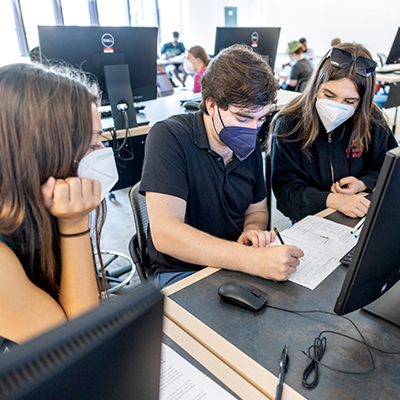
Flexible, technology-rich HSSC classrooms with ample room and moveable furniture make it easy for students to move from whole-class discussion in the middle of the room to group pods for computers on the edges, encouraging collaboration and information sharing.
“In previous years, we had a little bit of shortage of classrooms, but mostly the problem was that rooms were too small for the number of students,” says Dack Professor of Chemistry Jim Swartz, a co-leader of the HSSC Project Leadership Team. “Classrooms have previously been designed based on an educational paradigm in which students sat still and listened to somebody talk at them. Any kind of active student engagement was made difficult by the classrooms where students had to sit in chairs like sardines.”
In comparison to classrooms from that bygone era, Swartz describes the HSSC, with all its technology, roominess, and adaptability, as “remarkably outfitted and highly flexible.
“I just came from a room with six D-shaped tables where students sat around the edges with computers,” he says. “They faced one another and had access to a big-screen monitor to share information with each other. This allows them to search for information privately, then share it on the large screen so everybody can see it and simultaneously have a face-to-face discussion. Then students can move to a set of tables with all students in the class. With this flexibility built in, you can do quite different kinds of pedagogies within the same classroom.”
This easily accessible technology and flexibility for students and professors alike is a welcome adjustment for Mirzam Pérez, professor of Spanish, who finds the HSSC classrooms to be more technologically predictable and uniform and pedagogically more flexible and adaptable than any she’s previously taught in.
“I can weave myself among the students with ease and I can supervise and fully interact and engage students,” she says. “When students ask questions, I can be there immediately and have access to boards on all four sides of the room to share information. I also use a lot of video and audio and I can toggle between videos or have two screens going at the same time. These classrooms allow me to do those things without fumbling and looking technologically challenged while trying to make things work. It’s just so much easier, and that part of the work that used to give me so much stress is just gone. The spaces are great. I mean, they’re modern, they’re ample, they’re beautiful. They just feel really complete.”
More Than Classrooms
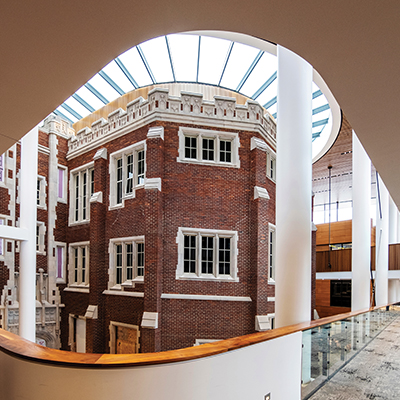 The HSSC, for all its updates and beauty, is still only as useful and effective as the people and programs that inhabit its space. Since its opening, the building has become a center for the Grinnellian spirit of inquiry and commitment to teaching and learning.
The HSSC, for all its updates and beauty, is still only as useful and effective as the people and programs that inhabit its space. Since its opening, the building has become a center for the Grinnellian spirit of inquiry and commitment to teaching and learning.
In addition to flexible, technology-infused classrooms, the HSSC is home to 145 faculty offices and dedicated research spaces grouped into five interdisciplinary neighborhoods that encourage multidisciplinary collaboration, active inquiry, student research, and “intellectual collisions.”
“These ‘neighborhoods’ make a difference in the way we operate and help facilitate a sense of community in a new way,” says Todd Armstrong, professor and department chair of Russian. “On a campus like Grinnell’s, you would think it wouldn’t be too hard to see other people and meet other people. But as the semester gets busy, unless someone’s on your pathway, you just wouldn’t see very many people. Now, we’re always seeing each other because we’re sharing space and having those serendipitous moments of connection and chance conversations that can build into really interesting things.”
The HSSC also serves as a home to many other initiatives and endeavors that are equally important to the College’s commitment to the liberal arts, to the humanities, and to educating citizens for active participation in democracy. Among them:
- The Grinnell Institute for Global Engagement (IGE) helps both students and faculty develop a greater understanding of the world through international travel opportunities, globally focused research, off-campus study, intensive language learning, and other short- and long- term experiences that advance Grinnell’s global learning goals.
- The Data Analysis and Social Inquiry Lab (DASIL) provides software training, experiential learning opportunities, student and faculty workshops, and in-classroom assistance to help students and faculty make better use of data so they can fully incorporate it into their research and classroom work.
- The Marcus Family Global Kitchen facilitates conversation, inquiry, community, and engagement through the study, preparation, and consumption of food.
Armstrong established a student team that helped develop a plan for the global kitchen that positions it to explore the role food plays in the human experience. He taught the first course in the kitchen in spring 2020.
“It's a remarkable venue in which to build community,” he says. “Everybody has a food story, and everybody can engage in that and then prepare and share food together. It’s really a high-impact kind of activity and it puts a premium on innovative learning and teaching and on our connections with the community.”
Though speaking of the global kitchen specifically, Armstrong’s thoughts reflect the campus buzz about the HSSC as a whole. There is widespread appreciation for the potential this building has already demonstrated to inspire effective teaching and learning at Grinnell.
“I keep pinching myself that this all came to pass,” he says. “There’s this sort of energy that you can sense here in the heart of the building. Students and everyone else who uses the space come out with a bounce in their step, and that’s really gratifying.”
HSSC Recognized for Continuing Architectural Excellence at Grinnell
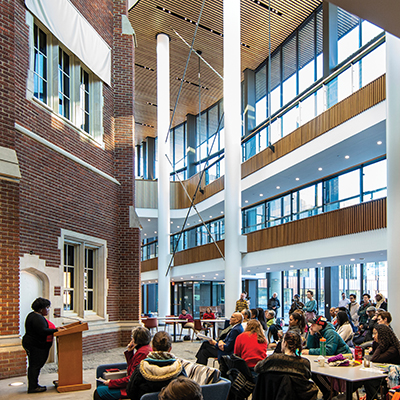
Grinnell College was recently honored by the Iowa Architecture Foundation for its sustained contributions, vision, and leadership in architecture and planning for more than 50 years, culminating in the Humanities and Social Studies Center.
The selection committee wrote of Grinnell:
“Going back to the 1960s, Grinnell College has consistently sought to employ some of the best American architects to add to what was already an idyllic campus. In 1999, the College employed Shepley Bulfinch Richardson and Abbott (Boston), to create a campus master plan that has been more recently updated by OPN Architects (Des Moines, Cedar Rapids). Over the past 12 years, the College has executed four extraordinary buildings within the context of this master plan, including the stunning Humanities and Social Studies Center, which unifies and greatly adds to two landmark buildings — the 1917 Alumni Recitation Hall and the 1905 Carnegie Hall — to create an immersive, tech-rich environment in which flexible and adaptable design fosters working synergies among students and faculty by supporting active, collaborative learning.”
Learn more about the HSSC learning spaces named in honor of partners to the College who, through their gifts, help shape and elevate the educational experience at Grinnell.

